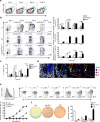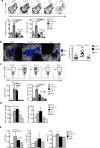TFH cells progressively differentiate to regulate the germinal center response
- PMID: 27573866
- PMCID: PMC5030190
- DOI: 10.1038/ni.3554
TFH cells progressively differentiate to regulate the germinal center response
Abstract
Germinal center (GC) B cells undergo affinity selection, which depends on interactions with CD4(+) follicular helper T cells (TFH cells). We found that TFH cells progressed through transcriptionally and functionally distinct stages and provided differential signals for GC regulation. They initially localized proximally to mutating B cells, secreted interleukin 21 (IL-21), induced expression of the transcription factor Bcl-6 and selected high-affinity B cell clones. As the GC response evolved, TFH cells extinguished IL-21 production and switched to IL-4 production, showed robust expression of the co-stimulatory molecule CD40L, and promoted the development of antibody-secreting B cells via upregulation of the transcription factor Blimp-1. Thus, TFH cells in the B cell follicle progressively differentiate through stages of localization, cytokine production and surface ligand expression to 'fine tune' the GC reaction.
Figures







Comment in
-
Dances with cytokines, featuring TFH cells, IL-21, IL-4 and B cells.Nat Immunol. 2016 Sep 20;17(10):1135-6. doi: 10.1038/ni.3561. Nat Immunol. 2016. PMID: 27648538 No abstract available.
References
MeSH terms
Substances
Grants and funding
LinkOut - more resources
Full Text Sources
Other Literature Sources
Molecular Biology Databases
Research Materials
Miscellaneous

